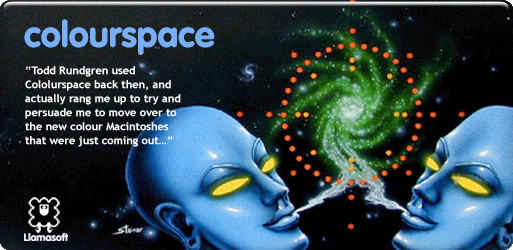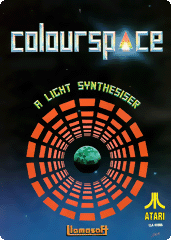Colourspace

Released: 1985
Colourspace, 8Bit
 This was the next major evolution of the lightsynth. The Atari machine had a much more extensive palette than the Commodore machines, plus you could make all kinds of interesting screen modes using the Display List Interrupt system, so it seemed like a natural machine to develop a next-generation lightsynth on. I still used the same basic algorithm as Psychedelia, but introduced a lot more colour variation, and colour cycling. There was also a provision for designing static graphics and logos on the screen and having the generated patterns flow over or under them, and many more symmetry modes afforded by the flexible hardware. Screens could have a cylindrical "curved" look since you could vary the vertical pixel size on a scanline by scanline basis, thanks to the DLIs.
This was the next major evolution of the lightsynth. The Atari machine had a much more extensive palette than the Commodore machines, plus you could make all kinds of interesting screen modes using the Display List Interrupt system, so it seemed like a natural machine to develop a next-generation lightsynth on. I still used the same basic algorithm as Psychedelia, but introduced a lot more colour variation, and colour cycling. There was also a provision for designing static graphics and logos on the screen and having the generated patterns flow over or under them, and many more symmetry modes afforded by the flexible hardware. Screens could have a cylindrical "curved" look since you could vary the vertical pixel size on a scanline by scanline basis, thanks to the DLIs.
With the extra colour and screen modes this became my "performance" lightsynth of choice, and we'd run videos and live demos of it in operation on a big telly at computer shows.
Paul Daniels bought a copy and I was once rude to him when he rang me up after some tech support and I was in the middle of coding };-). *Nobody* disturbs a coding yak };-).
Released: 1986
Colourspace, 16bit
When I finally got my hands on Atari's new machine, the first thing I set out to create on it was a new version of my lightsynth. The major difference this time was that although I still used the Psychedelia algorithm, much more precise and fluid control was possible, since instead of moving the cursor with an 8-way joystick, one could move it fluidly and smoothly with the mouse. This was also the most colourful lightsynth to date, due to the ST's large palette and 16-colour indexed display mode. I incorporated a feature that let you import pictures created in Atari's free paint program NEOchrome (written by Dave Staugas, who I would get to meet years later at Atari). Mo Warden made me some lovely colour-cycling overlay images to use in Colourspace, including the famous "Colourspace heads".
This was the first lightsynth that was versatile enough to really put on a proper show. You could bind your images to keys and select palettes and colour cycle sets from the keypad and in doing so build up a sequence for a reasonably lengthy performance. We hired the London Planetarium for the launch, and held a big party there. I performed a set I'd rehearsed to a few songs, and then me and the guy who operated the Laserium show there (who I'd got to know on my frequent post-computer-show trips with mates to the laser show) did a laser/Colourspace jam. Shortly after that party I bought my first projector, from the people I'd hired the projectors for the party from - a whopping great Barco 3-lens job that took two people to carry, took an hour to set up, and cost me 6 grand! (And wasan't anywhere near as good as any old cheapo LCD you can pick up now for a few hundred notes).
That projector became a regular feature of parties and of the Llamasoft display at computer shows. I worked out a set to "Dark Side of the Moon" and at one show we were doing performances on the hour, every hour - until we were asked to stop because the people crowding round our stand to see were obstructing free passage and creating a fire hazard }:-).
Colourspace was also the first lightsynth of mine that I found out a professional musician actually used - Todd Rundgren used it back then, and actually rang me up to try and persuade me to move over to the new colour Macintoshes that were just coming out - something I couldn't really justify doing since they were very expensive machines at that time!
Platforms
- BBC Micro
- Atari 8 Bit
- Atari ST













